James Maliszewski's Blog, page 26
March 10, 2025
Musings on Poll Results (Part I)
The first three polls are now closed and I'd like to share the results. The first poll was How many people – players + referee(s) – were there in your gaming group at the time you first started roleplaying? yielded the following, based on 342 votes:
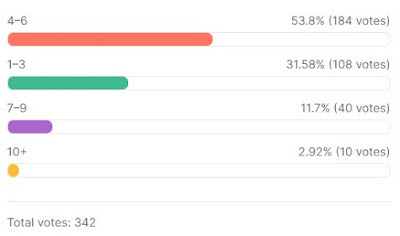
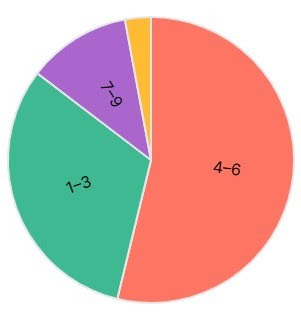 These results were a little bit of a surprise to me. Remember that the question was about your first gaming group, not your present one. When I entered the hobby in late 1979, my gaming group had seven players and that didn't seem to be all that unusual. Most of the other groups I encountered had more than six players, with quite a few having 10 or more. However, based on the results above, that wasn't quite as common as I had imagined, with 4–6 players being far more so.
These results were a little bit of a surprise to me. Remember that the question was about your first gaming group, not your present one. When I entered the hobby in late 1979, my gaming group had seven players and that didn't seem to be all that unusual. Most of the other groups I encountered had more than six players, with quite a few having 10 or more. However, based on the results above, that wasn't quite as common as I had imagined, with 4–6 players being far more so.The second poll was How many people – players + referee(s) – are in your gaming group at present? and yielded results consonant with the first one, based on 417 votes:

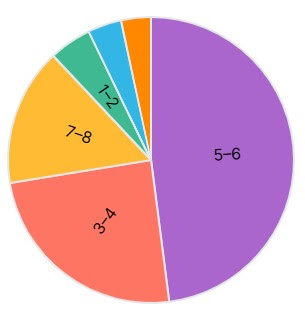 As you can see, the numbers aren't much different, with 5–6 players representing almost half of all voters. The biggest shift is at the high end, where the number of voters whose gaming group has 7 or more players has grown from slightly less than 15% in the first poll to slightly more than 20% in the second one. I'm actually rather heartened by seeing that, as I think larger groups are generally better than smaller ones.
As you can see, the numbers aren't much different, with 5–6 players representing almost half of all voters. The biggest shift is at the high end, where the number of voters whose gaming group has 7 or more players has grown from slightly less than 15% in the first poll to slightly more than 20% in the second one. I'm actually rather heartened by seeing that, as I think larger groups are generally better than smaller ones.The third and final poll I'll discuss today is How long are your RPG sessions?, which yielded the following, based on 467 votes:
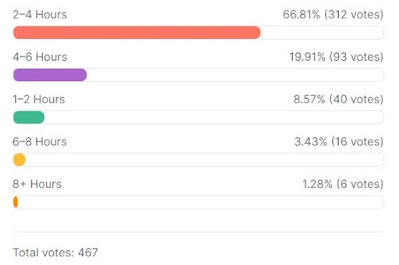
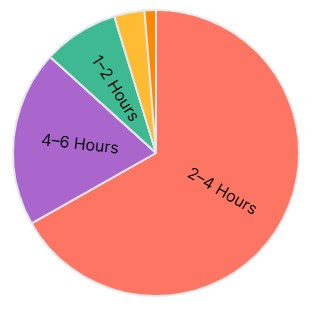 These results did not surprise me. Slightly more than two-thirds of the votes were cast for 2–4 hours, which has been the typical length I've observed for the last decade or more. In my youth, we used to have marathon sessions that lasted 8 hours or more, but I'm far too old to do that anymore and have been for some time. In addition, lots of us play online nowadays, so anything longer than 4 hours staring at a screen is generally too much. That said, there were still people who voted for sessions of 6+ hours, so not everyone is as lacking in stamina as I.
These results did not surprise me. Slightly more than two-thirds of the votes were cast for 2–4 hours, which has been the typical length I've observed for the last decade or more. In my youth, we used to have marathon sessions that lasted 8 hours or more, but I'm far too old to do that anymore and have been for some time. In addition, lots of us play online nowadays, so anything longer than 4 hours staring at a screen is generally too much. That said, there were still people who voted for sessions of 6+ hours, so not everyone is as lacking in stamina as I.This is all useful information to me, if only to get a better sense of Grognardia's readership. It's also helped me formulate some additional questions that I'll post in the future, such as "How often do you get together to play?" and "In how many campaigns are you currently participating?" If there are other questions you'd like me to ask in polls, please let me know in the comments.
March 9, 2025
How Old Were You When First Started Playing Tabletop RPGs?
Like previous polls, this one is necessarily limited. I lumped anyone under the age of 6 into a single category on the assumption that very few people first play tabletop RPGs at that age. Likewise, anyone age 21 or older gets put into a single category. In both cases, that's a function of my own experience of entering the hobby. If enough people vote for either of those categories, I may do a subsequent poll that expands upon them, but my gut tells me that most people who read this blog probably started roleplaying between the ages of 6 and 20, with the vast majority being somewhere in the 10 to 14 range. We'll see if I'm correct in this assumption.
Loading...
How Old Were You When First Started Playing Tabletop RPG?
Like previous polls, this one is necessarily limited. I lumped anyone under the age of 6 into a single category on the assumption that very few people first play tabletop RPGs at that age. Likewise, anyone age 21 or older gets put into a single category. In both cases, that's a function of my own experience of entering the hobby. If enough people vote for either of those categories, I may do a subsequent poll that expands upon them, but my gut tells me that most people who read this blog probably started roleplaying between the ages of 6 and 20, with the vast majority being somewhere in the 10 to 14 range. We'll see if I'm correct in this assumption.
Loading...
March 7, 2025
Campaign Updates: Ten Years
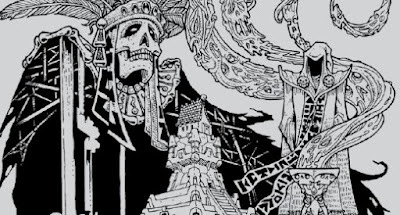 Because of unexpected real life distractions, I didn't referee either Barrett's Raiders or Dolmenwood this week. Despite that, I wasn't about to cancel this week's House of Worms session, since it marked the tenth anniversary of the campaign, which began on Friday, March 6, 2015. As I've written numerous times, I never, in my wildest dreams, imagined that this campaign would prove so durable. When I started it, I expected that it would probably last several months, maybe a year at most. After all, Tékumel is a hard sell to most gamers and Empire of the Petal Throne, the rules I elected to use to run the campaign, were very old, among the oldest ever published. Furthermore, I had no plan or expectations for House of Worms. I began the campaign simply as a way to scratch an itch and nothing more. In retrospect, it's quite possible that all of these supposed negatives actually worked in the campaign's favor and contributed to its longevity.
Because of unexpected real life distractions, I didn't referee either Barrett's Raiders or Dolmenwood this week. Despite that, I wasn't about to cancel this week's House of Worms session, since it marked the tenth anniversary of the campaign, which began on Friday, March 6, 2015. As I've written numerous times, I never, in my wildest dreams, imagined that this campaign would prove so durable. When I started it, I expected that it would probably last several months, maybe a year at most. After all, Tékumel is a hard sell to most gamers and Empire of the Petal Throne, the rules I elected to use to run the campaign, were very old, among the oldest ever published. Furthermore, I had no plan or expectations for House of Worms. I began the campaign simply as a way to scratch an itch and nothing more. In retrospect, it's quite possible that all of these supposed negatives actually worked in the campaign's favor and contributed to its longevity.That said, House of Worms is winding down and has been for some months now. A combination of factors has contributed to declining player attendance throughout 2024, something I can completely understand. When we all first gathered a decade ago to play, no one present had any reason to imagine we'd still be going so many years into the future. None of the players, including those who remain from the original six, is under any obligation to keep at this indefinitely, especially when so many of the larger threads of the campaign have either been tied up or are in the process of doing so. Even if attendance hadn't been getting spottier, it's just as likely that House of Worms would have wrapped up any way. How does one top the death of the emperor of Tsolyánu and the choosing of his successor from among his heirs, one of whom is a player character?
On that front, the characters have continued their investigations into the unusual circumstances of Kirktá's early life, as the entire empire prepares for the funeral of emperor Hirkáne Tlakotáni, the "Stone Upon Which the Universe Rests." Armed with the information recently obtained, Nebússa called upon a contact in the Omnipotent Azure Legion, the secret police of Tsolyánu, which, among other duties, looks after the imperial succession. His contact was a man who acted as a liaison between the OAL and the Court of the Purple Robes, the court bureaucrats of the emperor. He listened to Nebússa's request and told him that he could probably find out more but that it would take time. He also warned that doing so would probably draw attention to the characters and their activities. "This close to the ascension of a new emperor, many people will no doubt be looking into these matters."
Later that day, a non-descript young man came to Nebússa and the other characters, who were lodging at the Golden Bough clanhouse. The man gave the name of a priest at the Temple of Belkhánu in Béy Sü, saying that he would know more about Kirktá's early life. He also said that there was already an OAL agent in place, keeping an eye on him – someone who's been with him for years and is very close. He would not elaborate, adding only that "Others are also curious about Kirktá. You should be careful." Nebússa then began to ponder just who this OAL agent might be, with suspicion falling on Keléno, his long-time mentor. When confronted, Keléno replied, "So far as I know, I am not an OAL agent – which probably increases the likelihood that I am, in fact, one."
The matter unresolved, they visited the Temple of Belkhánu and sought out the priest, who was old and seemingly infirm. He claimed to know nothing of Kirktá. When Kirktá attempted to use ESP on him, it did not work, due to some kind of mind bar placed on him. When informed of this, Nebússa surreptitiously made use of sorcery to dispel the mind bar, which enabled Kirktá to then read the priest's mind. His thoughts were incredibly disciplined, making him still hard to read. What he could discern was that the priest was pleased to see Kirktá. "He has finally returned to us," he thought. "I should tell the others. They will be pleased." Nebússa and Grujúng then tailed the priest, to see if he did anything suspicious. When he did not, they returned to the Golden Bough clanhouse.
There, Nebússa used his magic to see if anyone else had been tampered with in any way. He discovered that he himself had been – certain of his own memories were blocked – and the same was true of Kirktá. However, the mind bar placed on Nebússa was "normal," whereas the one on Kirktá was both powerful and "wrong," which is to say, unlike any sorcery he'd encountered before. It was also "leaky," with "holes" in it, suggesting it was in the process of breaking down. This troubled the characters, who decided they needed to seek out someone more knowledgeable in sorcery than they. Keléno suggested reaching out to Toneshkéthu, a student at the College at the End of Time, whom they've known for years and whose existence is temporally out of sync with their own. Upon contacting her, she immediately said, "Oh, wonderful! You're finally getting to the good part."
And that was how we spent our tenth anniversary session of House of Worms.March 6, 2025
REVIEW: Sun County
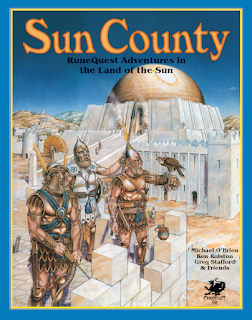
When RuneQuest burst upon the roleplaying game scene in 1978, it quickly became known for both its percentile-based skill system (which would later become the basis for Chaosium's house system, Basic Role-Playing) and its rich Bronze Age fantasy setting, Glorantha. Glorantha is steeped in mythology, both real and fictional, which not only distinguishes it from other fantasy RPG settings but has also made it one of my favorite imaginary settings of all time.
Between 1979 and 1983, Chaosium released numerous superb supplements, many of them boxed sets, fleshing out Glorantha to the delectation of its growing legion of fans. Then, in 1984, Chaosium entered into a deal with wargames publisher, Avalon Hill, who'd publish a new edition of RuneQuest but stripped of Glorantha. Though the company reversed this decision later, its support for Glorantha was desultory at best, much to the disappointment of long-time devotees.
I wasn't one of these devotees. I knew of RuneQuest, of course, but I was a diehard player of Dungeons & Dragons and indeed somewhat skeptical of RQ at the time. Consequently, I largely missed out on the game until the early 1990s, when Avalon Hill hired Ken Rolston to revitalize its version of the game. This he did through a renewed focus on Glorantha. His tenure kicked off a RuneQuest renaissance that gave birth to multiple excellent expansions of Glorantha, many of which are still regarded as classics. This was the period when I first fell in love with the setting, a love that has only grown in the three decades since.
Currently, RuneQuest and Glorantha are undergoing what might well be called a second renaissance. Since the publication of RuneQuest: Roleplaying in Glorantha in 2018, Chaosium has released a steady stream of excellent new material for the game and its setting. Just as importantly, the company has made a lot of its older material available again in electronic and print-on-demand form, both through its own store and through DriveThruRPG. Its most recent classic re-release is Sun County, written by Michael O'Brien, with contributions from Rolston, Glorantha creator Greg Stafford, and others.
Before discussing the contents of the book itself, I'd like to briefly comment on the 2024 remastering. The book's interior layout is clear and straightforward. It makes use of two columns and splashes of column – titles, headers and footers, tables, etc. It's been years since I saw the 1992 original, so I can't say if the use of color is new, but it's attractive nonetheless. There's a new foreword by Shannon Appelcline, which contextualizes Sun County within the larger history of RuneQuest (some of which I've mentioned above). As someone who enjoys learning about the history of the hobby, I love this sort of stuff and am glad it was included.
Originally published in 1992, the 2024 re-release of Sun County is a 124-page sourcebook, packed with detailed setting material, rules expansions, and adventure scenarios. The first half of the book is dedicated to fleshing out the region of Sun County itself – its geography, culture, and history – while the second half presents a series of interconnected adventure that showcase different aspects of the rigid society of the Sun Dome Templars, a militant theocracy devoted to Yelmalio, Son of the Sun. As a setting, Sun County is one of isolationism and decline. The Sun Domers are a proud but stiflingly conservative people, desperately clinging to a past that has long since left them behind. Their deity, Yelmalio, is cold and indifferent sun and their stiff hierarchy, strict moral codes, and inflexible traditions make them an excellent counterpoint to the vibrant and increasingly chaotic world around them. Sun County leans into these themes, both in its descriptive text and in the several included scenarios.From a presentation standpoint, Sun County stands out for its strong authorial voice. This is not an encyclopedic setting book filled with dispassionate information but rather a living, breathing culture, conveyed through in-character documents, legends, and anecdotes (as well as game mechanics). This has long been a hallmark of the better Gloranthan materials, but Sun County does it with a degree of clarity and usability that makes it, in my opinion, much more accessible than other books of this kind. The reader still needs to be already familiar with Glorantha, of course, but Sun County does a good job of explaining itself without too many references to other products.
The reader is treated to details about the cult of Yelmalio and related subcults, as well as the Sun Dome Temple itself, the seat of both religion and government within the County. Equally well detailed are its elite soldiers and citizen levies, which play significant roles here. A collection of random encounters and events serve both as sparks for adventures and to highlight unique aspects of Sun County, like the Yelmalian beadles who deal with unlicensed beggars or succubi who prey upon the sexually inhibited Sun Domers. These sorts of details flesh out the setting in straightforward, practical ways that I appreciate.
As I mentioned earlier, slightly more than half the book consists of adventures set in and around Sun County. Two of these pertain to a Harvest Festival in the town of Garhound, just beyond its borders. Garhound makes a great starting point for non-Yelmalian characters to visit the land of the Sun Domers. Another scenario affords characters the opportunity to become landowners in the County, while two further adventures concern the locating of lost artifacts associated with Yelmalio. There's also a collection of ideas for the Gamemaster to flesh out on his own. Taken together, these scenarios cover a lot of ground, though I do wish there'd been a few that dealt more directly with navigating the ins and outs of Sun County's often-strict society.
The book features strong black-and-white illustrations by Merle Insinga and Roger Raupp (the latter of whom also did the cover) that reinforce the setting’s stark, sun-bleached aesthetic. The imagery depicts the militaristic and hierarchical nature of Sun County, though there are also plenty of pieces that highlight other sides of the setting, like the contests of the Harvest Festival and the hidden threats to the region. The maps, though functional, are generally not as evocative as those found in earlier, Chaosium era products like Pavis or Big Rubble, but they serve their purpose well enough.
Sun County is a great setting book. It captures something rarely seen in RPGs: a genuinely believable culture, shaped by its environment and history, filled with tensions that make it ripe for adventure. This is precisely the kind of supplement I like, where cultural and philosophical conflicts drive the action as much as physical threats. More than thirty years after its original release, Sun County holds up very well. Its portrayal of the Sun Domers is compelling but nuanced, like the best Gloranthan supplements, then or now. It makes a great addition to any campaign set in or near New Pavis and the River of Cradles. Sun County's main downsides are that it was written for RuneQuest's third (Avalon Hill) edition and, as such, its game statistics and the political situation depicted within it will need to be updated if used in conjunction with the current version of the game. That's a small criticism of what is otherwise an excellent and well-presented supplement. I hope its publication is a portent of more to come in this vein from Chaosium.March 5, 2025
Unlock the Wonders and Mysteries of Ancient Egypt
Since I mentioned it my earlier post, I thought it worthwhile to share the original advertisement for The Valley of the Pharaohs I remember seeing in Dragon. This particular one appeared in issue #77 (September 1983).
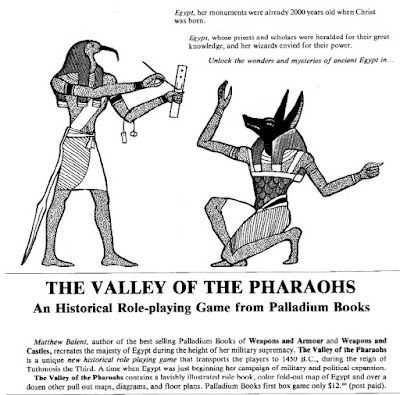
March 4, 2025
Retrospective: Valley of the Pharaohs
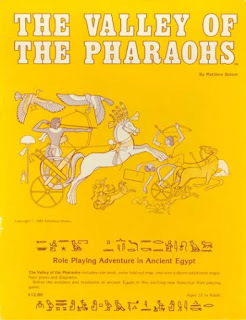
I've said before that I have very little direct experience with Palladium Books or its roleplaying games. With the exception of my old college roommate, I never knew anyone who played any of their games, despite the fact that there seem to be a huge number of them. Even so, I was aware of the existence of Palladium and its products through the advertisements that regularly appeared in the pages of Dragon. One that particularly fascinated me was The Valley of the Pharaohs, which first appeared in 1983. Recently, a friend of mine pointed out to me that the game was available as an inexpensive PDF from DriveThruRPG, so I grabbed a copy and finally had a chance to look at it after all these years.
In its original form, The Valley of the Pharaohs was a boxed set, consisting of a rulebook, a colored map of Egypt, and about a dozen other maps and diagrams. The rulebook is only 64 pages – short by contemporary standards perhaps but very much in keeping with many RPGs of its time. Written by Matthew Balent, who worked on a number of other early Palladium products, it's designed for adventuring in the political, religious, and mythological world of New Kingdom Egypt. Unlike Palladium’s more well-known roleplaying games, with their kitchen sink approaches to setting design, The Valley of the Pharaohs focuses on a rather more grounded, historically-informed presentation of ancient Egypt, though it does allow for supernatural elements such as magic (or magick, as the book styles it), the intervention of gods, and a handful of fantastic monsters.
In The Valley of the Pharaohs characters are built around occupations appropriate to the ancient Egyptian setting, like scribes, priests, soldiers, merchants, artisans, and so on. Occupations are largely distinguished from one another by the skills they provide the character. The game places some emphasis on social standing (or caste), as ancient Egyptian society was hierarchical, like most pre-modern societies. Caste determines which occupations a character can enter, as well as providing a bonus to a particular attribute. In a certain sense, caste is a replacement for race, since there are no playable non-humans in The Valley of the Pharaohs.
Combat is fairly straightforward and leans toward the lethal, in keeping with the idea that violence is not always the best option in a world where political maneuvering and religious influence are just as important as swordplay. Players are encouraged to use guile, diplomacy, and careful planning to navigate ancient Egyptian society, since there are strictures in place that against as stops against typical "adventuring" behavior. The order and stability of the New Kingdom is repeatedly emphasized, as are the potential problems that come with the characters acting without sanction in a way that could potentially upend that order.
The game's commitment to presenting ancient Egypt as a real place rather than simply a backdrop for fantasy adventure is readily apparent. The Valley of the Pharaohs provides details on daily life, religion, politics, and the role of different social classes. The gods of Egypt are an active presence, but they do not overshadow human action, nor do the limited kinds of spells available to player characters. Reading the rulebook, I couldn't shake the feeling that Balent was actually more interested in writing a sourcebook about ancient Egypt than he was in making a roleplaying game set in that time and place. This dedication to historical authenticity is a strength, as is its attempt to make social and political dynamics just as important as combat. At the same time, I can't help but wonder if this is what it's potential audience would have wanted from a game like this.
There is little in the way of extended campaign guidance and the adventure hooks provided are limited to the point of being skeletal. This would almost certainly make it difficult for a referee unfamiliar with ancient Egypt to know where to begin. It's too bad, because Balent packed a lot of genuinely interesting details in this short volume, but most of it tends toward the encyclopedic rather than the practical. When combined with the fact that The Valley of the Pharaohs has given only a limited amount of attention to fantastical or supernatural topics, its utility strikes me as limited. Who is this game for and what would they do with it?
On the plus side, The Valley of the Pharaohs is amply illustrated throughout, both in the form of black and white line drawings throughout the rulebook and separate maps. I really like the artwork, as it depicts lots of mundane aspects of ancient Egypt, such as clothing and wigs, that are important to both players and referees in establishing the setting. The maps and diagrams are similarly well done and useful for gameplay, particularly when exploring tombs and temples. In many ways, these are among the most important parts of Valley of Pharaohs, since gamers often need good visual guides of settings that deviate from the tropes of vanilla fantasy.
The Valley of the Pharaohs is, so far as I know, a one-off book and received no additional support from Palladium. This makes it a fascinating historical curiosity, especially in light of the subsequent direction of its publisher. As someone with a lifelong interest in ancient Egypt, I'm glad that I finally got the chance to read this game, even if it's deficient in a lot of ways. Unfortunately, it doesn't have a lot of competition within its historical niche. Ancient Egypt is, alongside ancient Greece and Rome, a go-to reference point for fantasy and, by extension, fantasy roleplaying. One would reasonably expect that Egypt would have had more RPGs inspired by it and yet that doesn't seem to be the case. How odd!March 3, 2025
The More You Know
I make no bones about the fact that I have long been – and still am – a fan of Ed Greenwood's Forgotten Realms setting. Of course, I do place an important caveat on that statement. When I say "Ed Greenwood's Forgotten Realms setting," I mean that quite literally. I'm a fan of the setting as Ed Greenwood originally presented it in the pages of Dragon magazine rather than the version(s) of the setting presented in products published by TSR and Wizards of the Coast. I still enjoy some of that later published material, but, for me, the Forgotten Realms that I love is the one Greenwood wrote about in his many Dragon articles, especially during the early to mid-1980s. That's why you'll find quite a few of those articles featured in my Articles of Dragon series.
The reason for this is simple: those articles don't explain everything. Instead, they're filled with offhand references and allusions to people, places, and historical events without any clarification. Those references provide color and occasionally context, but their purpose isn't to give the reader a lengthy dissertation on the history of the Realms, let alone something more obscure. Strictly speaking, they could be stripped out of the description of that sword and it would still be perfectly usable in play. However, it wouldn't be as fun to read nor would it be as evocative. Those allusions create a sense of depth, making the world feel larger and more lived-in. They hint at a larger, interconnected setting filled with legends, conflicts, and figures whose stories remain untold. This approach also invites curiosity, encouraging the reader to imagine connections or even incorporate those elements into his own campaign. Without them, the text might be clearer but also flatter, lacking the richness that makes the setting feel like a place rather than just a backdrop.
Unfortunately, as Greenwood's setting was elaborated upon beyond those original articles, there wasn't a lot that remained forgotten about the Realms. With each new supplement, novel, or sourcebook, more of the implied history and mystery was brought into the light, codified, and explained in detail. While this expansion enriched the setting for dedicated fans, it also diminished some of its initial allure. The obscure references that once sparked my imagination were now meticulously documented, leaving less room for speculation. It was probably an inevitable outcome, given the demands of game publishing, but it's a little disappointing nonetheless.
While I've singled out the Forgotten Realms in this post, it's not the only imaginary setting that suffers from this problem. Even my beloved Tékumel, in which I've refereed the House of Worms campaign for just shy of ten years, has far too much background material than is necessary. In fact, in the case of Tékumel, the depth of background material can be as much a turn-off for newcomers as an enticement. The same could be said of other well-established settings, like Glorantha or the Third Imperium, both of which I love, by the way. I'm not approaching this simply from the perspective of ease of use but also one of enjoyment. I often feel as if less is more when it comes to many settings. Their allure is, to a great extent, their "empty spaces," which is to say, those parts that are, at best, alluded to rather than so fully fleshed out that every possible question already has an answer before play has begun.
I think about this a lot, as I soldier ahead with Secrets of sha-Arthan. Though sha-Arthan takes inspiration from RPG settings like Glorantha, Jorune, and, of course, Tékumel, I have been attempting to avoid their excesses when it comes to the presentation of the setting. That's why I've taken a few cues from those early Forgotten Realms articles, for example, and why I have no plans to produce an encyclopedia of sha-Arthan or anything even close to it. Instead, I want to present an exotic but accessible science fantasy setting with lots of mysteries I'll never solve and even more scope for referees and players to make it their own. In the coming weeks, I'll be sharing some examples of just how intend to do this.
In the meantime, I'm curious: what, in your opinion, is an example of a RPG setting that does a good job with its presentation – one that's compelling without being constraining? One that is rich with detail and atmosphere but leaves plenty of space for players and referees to make it their own?Fight On! Fights On
 Editor extraordinaire, Ignatius Ümlaut, has informed me that issue #16 of the flagship fanzine of the Old School Renaissance,
Fight On!
, is now available in both print and digital forms. Dedicated to the late, great Dave Trampier, this 128-page issue includes excellent contributions by a wide variety of writers and artists – from Dave Hargrave and Tim Kask to Peter Mullen and Cameron Hawkey, not to mention Sean "Stonegiant" Stone, Oakes Spalding, Simon Bull, Gabor Lux, Kevin Mayle, Evlyn Moreau, Calithena, Paul Carrick, Sophie Pulkus, J. Blasso-Gieseke, bät, Attronarch, Philipp H., Settembrini, Robert S. Conley, Idle Doodler, DeWayne Rogers, Rick Base, Dyson Logos, Jon Salway, Becami Cusack, Tony A. Rowe, Prince of Nothing, Jasmine Collins, Anthony Stiller, Allan T. Grohe Jr., Will Mistretta, Steve Queen, Zhu Baijee, Thomas Denmark, and many, many more (including yours truly).
Editor extraordinaire, Ignatius Ümlaut, has informed me that issue #16 of the flagship fanzine of the Old School Renaissance,
Fight On!
, is now available in both print and digital forms. Dedicated to the late, great Dave Trampier, this 128-page issue includes excellent contributions by a wide variety of writers and artists – from Dave Hargrave and Tim Kask to Peter Mullen and Cameron Hawkey, not to mention Sean "Stonegiant" Stone, Oakes Spalding, Simon Bull, Gabor Lux, Kevin Mayle, Evlyn Moreau, Calithena, Paul Carrick, Sophie Pulkus, J. Blasso-Gieseke, bät, Attronarch, Philipp H., Settembrini, Robert S. Conley, Idle Doodler, DeWayne Rogers, Rick Base, Dyson Logos, Jon Salway, Becami Cusack, Tony A. Rowe, Prince of Nothing, Jasmine Collins, Anthony Stiller, Allan T. Grohe Jr., Will Mistretta, Steve Queen, Zhu Baijee, Thomas Denmark, and many, many more (including yours truly). It's this "ecumenical" approach to old school gaming that, in my opinion, distinguishes Fight On! Its contents are incredibly diverse, representing everything from the groggiest of grognard takes to more new-fangled, "old school-inspired" approaches. Not every article is going to appeal to everyone – and that's OK. Fight On! reminds me of what Dragon was like during my youth, when each issue was a grab-bag of the unexpected, some of which I could immediately use and some of which I only came to appreciate later. That's as it should be. Speaking only for myself, I know only too well how easy it is to get trapped inside my own head, limiting myself to my own comfortable ways of thinking. Fight On! shakes me out of my complacency, offering me ideas and imagery that I might otherwise not have considered. I have no doubt that it'll do the same for you.
March 2, 2025
When Were You First Introduced to Roleplaying Games?
So, for today's poll, I've presented lots of three-year periods – from 1974 to 2000 – in which readers can identify the period when they first started roleplaying. My apologies to anyone who entered the hobby from 2000 on. I've compressed the last quarter-century into a single option, both for my convenience and out of a sense that it'll still be a minority choice. If I'm wrong about that, I can always do a follow-up poll to distinguish between the various three-year blocs of the last 25 years.
Loading...
James Maliszewski's Blog
- James Maliszewski's profile
- 3 followers



